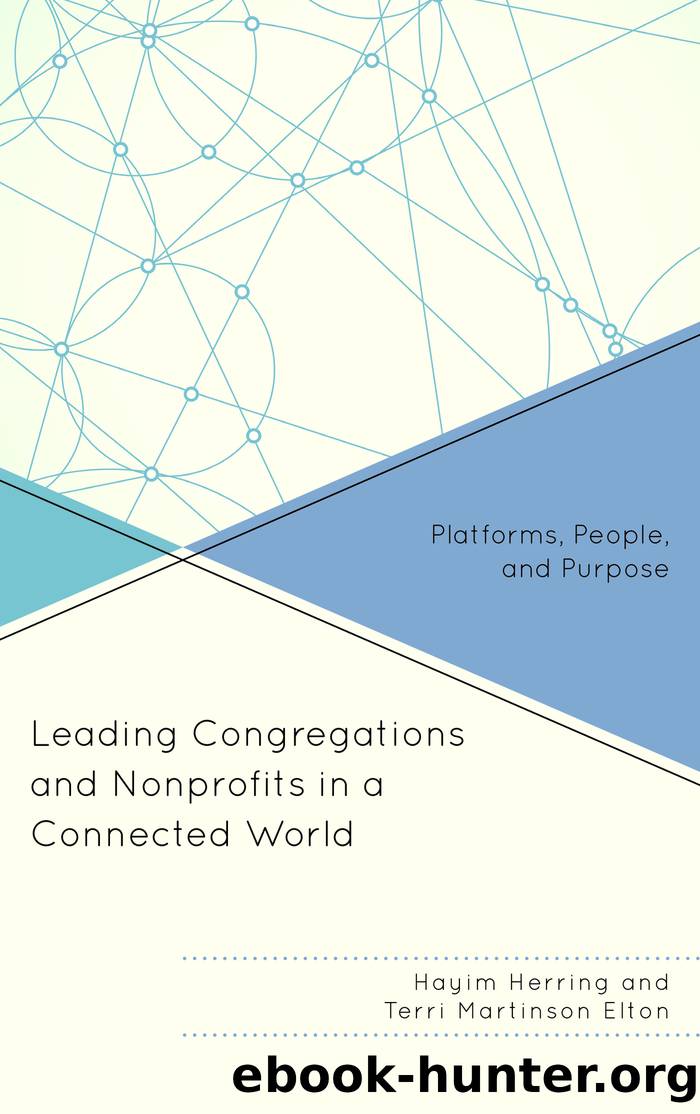Leading Congregations and Nonprofits in a Connected World by Herring Hayim;Elton Terri Martinson;

Author:Herring, Hayim;Elton, Terri Martinson;
Language: eng
Format: epub
Tags: undefined
Publisher: Rowman & Littlefield Publishers
Published: 2012-08-15T00:00:00+00:00
Fusing the Model
Fusion is another pathway to innovation. In nuclear physics, when two lighter atomic nuclei collide at high speeds and become a heavier nucleus, they produce energy. By analogy, for our purposes, what is of interest is the merging of two distinct forms of entities into one that releases energy. An example of fusion in technology is the merging of printing and manufacturing technologies that produced the 3D printer. Many fitness clubs have fused two concepts that used to be separate not long ago: eating healthy and exercising, so that exercise and diet have become fused into a more holistic, integrated approach to healthy living. Today, fusing different styles of music, or cuisine from different cultures, are common ways to surprise the ear and delight the palate, when done by experts who meld the best of disparate traditions into creative, unique, memorable consumer experiences.
Most congregations will not be able to afford the significant capital and human resources that are required for the long-term research and development (R&D) that produces truly breakthrough innovations. However, fusion is a well-tested strategy for innovation. Its advantage as a strategy for congregations and nonprofit organizations that tend to be or become more conservative is that it retains something familiar, but through a âcollisionâ with a different category, enlivens constituents with new experiences.
In our study, the Jewish congregation that best illustrates a fusion model is Romemu. Its mission statement captures its intentionality of innovation through fusion. âRomemu is attempting to transform the way Judaism is practiced and experienced by infusing aspects of Eastern spiritual practices with traditional Orthodox influences, so the taâam or âtasteâ is unmistakably Jewish.â[14] Fusion as a pathway to innovation comes naturally; Rabbi David Ingber, Romemuâs founder and spiritual leader, embodies fusion on a personal level. His understanding of twenty-first-century Judaism integrates his experiences with Orthodox, Renewal, and mystical expressions of Judaism, and other faith and philosophical traditions. His leadership abilities have enabled him to translate a personal journey into a community of others who are attracted to or can identify with his journeys into, out of, and back through Judaism after absorbing wisdom from other expressions of Judaism and other spiritual traditions.
Rabbi Ingber also spoke to another type of fusion. While not completely comfortable with the pervasive consumerist mentality of many Americans, he stated that âthe older model of covenantal community must meet newer model of consumer America in a place where we will allow spiritual marketplace to tell us what practices are and are not working.â[15] He clarified that he does not believe that the marketplace should dictate the practice of Judaism, nor should traditional rabbinic hierarchies do so. Rather, he spoke about the need for balancing a âtop downâ and âbottom upâ approach, in which rabbis lead responsibly and responsively. A dynamic tension of this kind of fusion, that seeks to hold on to mission focus and market sensitivity, is a generator of innovation.
While we did not study other Jewish communities like the Kavana Cooperative[16] or The Kitchen[17] for this publication, they also illustrate other examples of fusion.
Download
This site does not store any files on its server. We only index and link to content provided by other sites. Please contact the content providers to delete copyright contents if any and email us, we'll remove relevant links or contents immediately.
Joan of Arc by Mary Gordon(3783)
Victory over the Darkness by Neil T. Anderson(2731)
The Gnostic Gospels by Pagels Elaine(2393)
Devil, The by Almond Philip C(2204)
The Nativity by Geza Vermes(2113)
The Psychedelic Gospels: The Secret History of Hallucinogens in Christianity by Jerry B. Brown(2072)
Going Clear: Scientology, Hollywood, and the Prison of Belief by Lawrence Wright(1880)
Going Clear by Lawrence Wright(1867)
A TIME TO KEEP SILENCE by Patrick Leigh Fermor(1771)
Barking to the Choir by Gregory Boyle(1726)
Old Testament History by John H. Sailhamer(1712)
Augustine: Conversions to Confessions by Robin Lane Fox(1686)
A History of the Franks by Gregory of Tours(1636)
The Bible Doesn't Say That by Dr. Joel M. Hoffman(1608)
A Prophet with Honor by William C. Martin(1602)
The Knights Templar by Sean Martin(1597)
by Christianity & Islam(1561)
The Amish by Steven M. Nolt(1488)
The Source by James A. Michener(1455)
